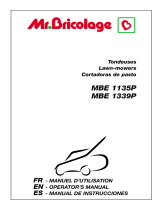
40
Italiano English Français
UTILIZZO USE UTILISATION
ATTENZIONE:
- Il rasaerba deve essere utilizzato solamente
per il taglio di superfici erbose in giardini o
parchi.
- Non usare il rasaerba se le maglie del sacco
raccoglierba sono rotte o intasate di erba.
- Arrestare sempre il motore prima di togliere il
sacco raccoglierba.
NOTA
- Se l'altezza dell'erba da falciare é eccessiva, effettuare
due passaggi: il primo all'altezza massima, il secondo
all'altezza desiderata.
- Falciare il prato a "chiocciola" dall'esterno verso
l'interno (Fig. 70, pag. 41).
INDICATORE SACCO PIENO
Sopra al sacco raccoglierba è presente un deflettore
indicatore di sacco pieno (A, Fig.71, pag.41). Quando il
deflettore è alzato (Fig.71, pag.41) sta ad indicare che il
sacco si sta riempendo d’erba. Quando invece il
deflettore è abbassato (Fig.72, pag.41) sta ad indicare
che il sacco è pieno ed è necessario vuotarlo.
USI PROIBITI
- Il rasaerba non deve essere utilizzato per il taglio di
altri materiali, in particolare per materiali che si
trovano al di sopra del livello del terreno, per i quali
sia necessario sollevare il rasaerba stesso.
- Il rasaerba non deve essere utilizzato per triturare
rami, o materiali più consistenti dell’erba.
- Il rasaerba non deve essere utilizzato per aspirare o
raccogliere dal terreno materiali consistenti,
polverosi, rifiuti di ogni genere, sabbia o ghiaia.
- Il rasaerba non deve essere utilizzato per spianare
rilievi o asperità del terreno; la lama non deve mai
toccare il terreno stesso.
- Il rasaerba non deve essere utilizzato per trasportare,
spingere o trainare altri oggetti, carrelli o simili.
- È proibito applicare alla presa di forza del rasearba
utensili o applicazioni che non siano quelli indicati
dal costruttore.
WARNING:
- The lawnmower must only be used for cutting
grassy areas in gardens or parks.
- Do not use the mower if the bag is worn or
clogged with grass.
- Stop the engine before taking the grass bag
out.
NOTE
- If the grass is too high make two cuts: the first one at
maximum height; the second at the desired height.
- Mow the lawn in a spiral from the edge to the centre
(Fig. 70, pag. 41).
FULL-BAG INDICATOR
There is a full bag indicator on top of the grass catcher
(A, Fig.71, page 41). When the flap is in its raised
position (Fig.71, page 41) this means that the grass
catcher is collecting grass cuttings. When the flap is in
its lowered position (Fig.72, page 41) this means that
the grass catcher is full and must be emptied.
PROHIBITED USES
- The lawnmower must not be used for cutting other
materials, particularly materials above ground level
that require the lawnmower to be raised above the
ground.
- The lawnmower must not be used to shred branches,
nor materials thicker than grass.
- The lawnmower must not be used to vacuum or
collect dense material, dust, refuse of any kind, sand
or gravel from the ground.
- The lawnmower must not be used to flatten uneven
or bumpy terrain; the blade must never come into
contact with the ground.
- The lawnmower must never be used to transport,
push or tow trailers or other similar objects.
- It is prohibited to fit implements or accessories other
than those supplied by the manufacturer.
ATTENTION:
- La tondeuse doit être utilisée exclusivement
pour tondre des pelouses dans des jardins ou
des parcs.
- Ne pas faire fonctionner la tondeuse si le sac
est usé ou endommagé.
- Toujours arrêter le moteur avant d'enlever le
sac à herbe.
NOTE
- Si la hauteur de l'herbe est excessive, effectuer deux
tontes successives: la première à la hauteur de coupe
MAX, la seconde à la hauteur souhaitée.
- Tondez votre gazon en "escargot", de l'extérieur vers
l'intérieur (Fig. 70, pag. 41).
TÉMOIN DE BAC PLEIN
Un déflecteur indiquant que le bac est plein
(A, Fig.71, page 41) se trouve au-dessus du bac de
ramassage. Lorsque le déflecteur est soulevé (Fig.71,
page 41), cela signifie que le bac est presque plein.
Lorsque le déflecteur est abaissé (Fig.72, page 41), cela
signifie que le bac est plein et qu'il faut le vider.
OPÉRATIONS INTERDITES
- La tondeuse ne doit pas être utilisée pour d'autres
matériaux, surtout si ces matériaux se trouvent au-
dessus du niveau du terrain, ce qui nécessiterait de
soulever la tondeuse.
- La tondeuse n'est pas conçue pour hacher des
branches ou des matériaux plus gros que l'herbe.
- Ne pas utiliser la tondeuse pour aspirer ou ramasser
des matériaux ou des objets volumineux (déchets,
sable ou gravier).
- La tondeuse n'est pas conçue pour niveler des reliefs
ou des aspérités du terrain ; la lame ne doit jamais
toucher le terrain.
- Ne pas utiliser la tondeuse pour transporter, pousser
ou tracter d'autres objets (tels que des chariots).
- Il est interdit de monter des outils ou des applications
sur la prise de force de la tondeuse autres que ceux
recommandés par le constructeur.






















